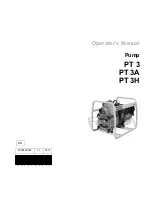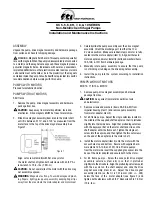
MA-AL-T75E-01-03 Manual TUL375EN eng rev3
Rev.3 Page 1 of 4
POWER SUPPLY TUL375 EN
CERTIFIED UNI EN54-4:2007. Included updating A1:2002 and A2:2006
Installation Manual
GENERAL FEATURES
The Power Supply TUL 375 has been designed to be used as a Power Unit with power reserve in Fire Alarm Systems in conformity to regulation (EU)
No 305/2011.
Its mechanical and electrical features make it complying to EN 54-4: 2007 Standard (Fire Alarm detecting and signaling devices. Part 4 : Power
supply devices) which includes A1:2002 and A2:2006 updates.
FUNCTIONAL FEATURES
The power supply unit is made by a linear power supply, series adjustment, with serial voltage regulator, limited in constant precision current
(rectangular limitation), two 12V 17 Ah batteries (not given within) analogical control circuit and micro-controlled supervision circuit.
Supplying is divided on 3 terminal-outputs protected by fuses:
BAT: where the back-up battery will be connected
OUT 1, OUT2 and OUT3: for generic charges
The charge of the battery occurs at constant tension (27,6 V @ 25°C) with temperature compensation and current limitation. Maximum current supplied
by the power is 5 A with 3 A for charge and 2 A for the battery.
The LED on the control board are close to concerned fuses (see pict.1) and show:
-
Fuse cut for any of the outputs, with Led off (DL9, DL10, DL11)
-
Current consumed by charge (2 green and one red DL5, DL6, DL7)
-
Mains presence (DL1 RETE)
Check of battery efficiency
The power supply periodically carries out the efficiency of the batteries:
At first activation of the power supply, the microprocessor will carry out the test of battery presence after about 30 seconds. If connected, the test will
be carried out every 10 minutes whilst in case it is not connected, it will continue carry out the test every 20 seconds showing indication FAILURE.
During normal functioning, the efficiency of the battery is checked by controlling the batteries tension. If batteries do not manage to maintain an
acceptable tension during test, there will be the indication FAILURE.
A test of the internal resistance of the battery is carried out during normal functioning, every 1,5 hours (in conformity to attachment EN54-4/A2); if the
internal resistance is over 1 ohm, there will be a FAILURE indication. It will then be necessary to replace the batteries and check that terminals and
fuses have a good electrical contact. When the battery is replaced, with presence of mains tension, the test of internal resistance is repeated every 5
minutes.
A microcontroller system controls various possible anomalies and gives a FAILURE indication in the following conditions:
1.
Output Fuses interruptions
2.
Overloaded Battery (> 30 V)
3.
Low Battery Tension (< 21 V)
4.
Power absence and no battery charge
5.
Disconnected Battery
6.
Internal battery resistance >1
Ώ
The indication of failure together with the indication of mains absence are in a connector placed on the control and supervision board.
In order to avoid that a possible failure in the series regulator damages the charges or the battery, a protection circuit has been inserted against over-
tensions, made of a SCR and a fuse. A fuse for mains alternated supplying is also present.
In case of failure in the power supply or of mains missing, supplying of the logic and control circuits occurs by means of battery.
Electrical Specifications
Supplying tension
230 Vac +10% / -15%
Ac mains frequency
50 Hz sinusoidal
Current consumption by mains
1,1 A max. ( full load )
Output tension
27,6 Vdc ( -15% / +10%)
Minimum output tension
20 Vdc at max charge, with mains absence and battery
discharged
Switching-off threshold tension
20 Vdc
Output current
5 A max. (see pict.4)
Max current for battery recharge
3 A
Max current for charges
2 A
Regulations towards mains variations at full charge (+10% / -15%)
Better than 1%
Regulations towards charge variations (0 to 100%)
Better than 1%
Ripple at full charge
1 Vpp ( at 195,5 Vac ) 30mVpp ( at 253 Vac )
Compensation of output tension according to temperature
4 mV/ K
Protection against battery polarity inversion
Diode
Recommended batteries: 2 x 12 V in series, 17 Ah housing with
inflammability class UL-94-V2 or better
Type:YUASA NP 17-12 or equivalent.
Alarm threshold of battery internal resistance
1
Ω
Missing mains and failure output relay
– dry contacts
25 Vac or 60 Vdc 1A MAX






















